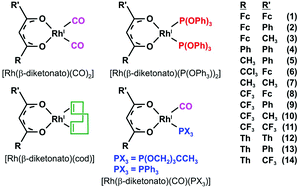Density functional theory calculations of Rh-β-diketonato complexes†
Abstract
Density functional theory (DFT) results on the geometry, energies and charges of selected Rh-β-diketonato reactants, products and transition states are discussed. Various DFT techniques are used to increase our understanding of the orientation of ligands coordinated to Rh, to identify the lowest energy geometry of possible geometrical isomers and to get a molecular orbital understanding of ground and transition states. Trends and relationships obtained between DFT calculated energies and charges, experimentally measured values and electronic parameters describing the electron donating power of groups and ligands, enable the design of ligands and complexes of specific reactivity.


 Please wait while we load your content...
Please wait while we load your content...